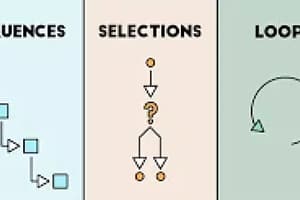Podcast
Questions and Answers
What is the primary difference between a while loop and a do-while loop?
What is the primary difference between a while loop and a do-while loop?
- The number of iterations in a while loop is fixed, whereas a do-while loop can iterate an infinite number of times.
- The condition in a while loop is evaluated at the beginning of each iteration, whereas in a do-while loop, it is evaluated at the end. (correct)
- A while loop is used for sequential execution, whereas a do-while loop is used for parallel execution.
- A while loop is used for conditional statements, whereas a do-while loop is used for unconditional statements.
What happens when the condition in a while loop evaluates to false at the beginning?
What happens when the condition in a while loop evaluates to false at the beginning?
- The loop will execute once before terminating.
- The statements within the loop will not be executed. (correct)
- The loop will skip to the next iteration.
- The loop will execute indefinitely.
What is the purpose of using a do-while loop?
What is the purpose of using a do-while loop?
- To execute a set of statements repeatedly.
- To skip a set of statements if a condition is false.
- To execute a set of statements only once.
- To ensure that a set of statements is executed at least once. (correct)
What happens when the condition in a do-while loop evaluates to false?
What happens when the condition in a do-while loop evaluates to false?
In what scenario would you use a do-while loop?
In what scenario would you use a do-while loop?
When is a while loop typically used?
When is a while loop typically used?
What is a key consideration when using nested loops?
What is a key consideration when using nested loops?
Why is it essential to test loops thoroughly?
Why is it essential to test loops thoroughly?
What is a benefit of using for loops?
What is a benefit of using for loops?
What should you consider when working with large datasets?
What should you consider when working with large datasets?
What is the purpose of using error handling within loops?
What is the purpose of using error handling within loops?
What is a key aspect of choosing the appropriate loop construct?
What is a key aspect of choosing the appropriate loop construct?
Why is mastering loops important for developers?
Why is mastering loops important for developers?
In a do-while loop, when is the condition evaluated?
In a do-while loop, when is the condition evaluated?
What is the primary purpose of a for loop?
What is the primary purpose of a for loop?
Which loop is best suited for scenarios where the number of iterations is unknown?
Which loop is best suited for scenarios where the number of iterations is unknown?
What is a key difference between a while loop and a do-while loop?
What is a key difference between a while loop and a do-while loop?
When would you use a do-while loop instead of a while loop?
When would you use a do-while loop instead of a while loop?
What is a common use case for a for loop?
What is a common use case for a for loop?
What is the purpose of initialization in a for loop?
What is the purpose of initialization in a for loop?
Which loop is preferred when the number of iterations is known beforehand?
Which loop is preferred when the number of iterations is known beforehand?
What is a common use case for a while loop?
What is a common use case for a while loop?
What is the purpose of the increment/decrement step in a for loop?
What is the purpose of the increment/decrement step in a for loop?
What is the main purpose of loops in programming?
What is the main purpose of loops in programming?
What is the significance of the condition in a while loop?
What is the significance of the condition in a while loop?
Why is it important to update variables within a while loop?
Why is it important to update variables within a while loop?
What is the consequence of a condition that could result in an infinite loop?
What is the consequence of a condition that could result in an infinite loop?
What is the purpose of initializing variables involved in the condition before entering a while loop?
What is the purpose of initializing variables involved in the condition before entering a while loop?
What is the characteristic of a while loop that makes it a pre-test loop?
What is the characteristic of a while loop that makes it a pre-test loop?
What is the role of the condition in a while loop?
What is the role of the condition in a while loop?
Why is it essential to understand the different types of loops in JavaScript?
Why is it essential to understand the different types of loops in JavaScript?
Flashcards are hidden until you start studying
Study Notes
Loops in JavaScript
- A do-while loop is always executed at least once, even if the condition evaluates to false.
- In a while loop, the condition is evaluated before executing the code block, and if the condition is false, the loop's code block will not be executed at all.
- In contrast, a do-while loop executes the code block first, and then checks the condition. If the condition is false, the loop terminates, but at least one iteration of the loop's code block is guaranteed to run.
Key Difference Between While and Do-While Loops
- While loop: the condition is checked before executing the code block.
- Do-while loop: the code block is executed first, then the condition is checked.
Example of a Do-While Loop
- Initialization:
i = 9 - Do block: executes the code block regardless of the condition, printing
i(which is 9) to the console and incrementingiby 1, making it 10. - Condition check: after executing the code block, the condition
iis evaluated, and if it's false, the loop terminates.
Introduction to Loops
- Loops allow developers to execute a block of code multiple times based on a condition.
- Understanding loops is crucial for writing efficient and readable code.
The while Loop
- Definition: A control flow statement that allows code to be executed repeatedly based on a given Boolean condition.
- Syntax:
while (condition) { // Code to execute }. - Guidelines:
- Initialize variables involved in the condition before entering the loop.
- Ensure the condition is correctly set to allow the loop to run as intended.
- Update variables within the loop to eventually meet the condition and terminate the loop.
- Avoid infinite loops by ensuring the terminating condition is met.
- Common use cases:
- Iterating through arrays or collections where the number of iterations is not known beforehand.
- Reading data from a source until a certain condition is met (e.g., end-of-file).
- Executing a block of code based on dynamic conditions that might change during runtime.
The do-while Loop
- Definition: A post-test loop where the loop's body is executed first, and then the condition is evaluated.
- Syntax:
do { // Code to execute } while (condition);. - Guidelines:
- Initialize variables before entering the loop.
- Ensure the code block executes at least once regardless of the condition.
- Update variables within the loop to ensure the condition is eventually false to terminate the loop.
- Place the condition at the end to control further iterations after the initial execution.
- Common use cases:
- User input validation loops where at least one input attempt is required.
- Menu-driven programs where the menu should display at least once before any condition check.
- Scenarios where the initial execution of the code block is mandatory before any subsequent logic.
The for Loop
- Definition: A control flow statement designed for iterating a specific number of times.
- Syntax:
for (initialization; condition; increment/decrement) { // Code to execute }. - Guidelines:
- Set the initial value of the loop control variable.
- Define a condition that must be true for the loop to continue executing.
- Update the loop control variable to progress towards meeting the terminating condition.
- Utilize the compact structure for loops where the number of iterations is fixed or known.
- Common use cases:
- Iterating over arrays and collections with a known number of elements.
- Executing a block of code a specific number of times.
- Looping through data structures with predetermined bounds.
Comparison of Loops
- Initialization:
- while and do-while loops: Initialization happens before the loop starts.
- for loop: Initialization is part of the loop structure.
- Condition Evaluation:
- while loop: Condition is evaluated before the loop's body executes.
- do-while loop: Condition is evaluated after the loop's body executes.
- for loop: Condition is evaluated before each iteration.
- Iteration and Update:
- while and do-while loops: Increment or update statements are placed inside the loop body.
- for loop: Increment or update statements are part of the loop structure.
Choosing the Appropriate Loop
- When to use while loop:
- When the number of iterations is not known beforehand.
- When iterating based on dynamic conditions that may change during runtime.
- When to use do-while loop:
- When the loop body must execute at least once regardless of the condition.
- When initial execution of the code block is necessary before any condition check.
- When to use for loop:
- When the number of iterations is known and fixed.
- For iterating over arrays, collections, or ranges with a known number of elements.
Practical Insights and Best Practices
- Readability and Maintenance:
- Choose the loop structure that enhances code readability and maintainability.
- Use descriptive variable names and clear comments to explain the purpose of the loop and the condition.
- Avoiding Infinite Loops:
- Ensure that the loop has a terminating condition that will be met.
- Test loops thoroughly to avoid infinite loops.
- Performance Considerations:
- Consider the efficiency of the loop and optimize where necessary.
- Be mindful of the time complexity of operations within the loop body.
- Nested Loops:
- Use nested loops sparingly and only when necessary.
- Optimize nested loops by minimizing the number of iterations and avoiding redundant operations.
- Error Handling:
- Implement error handling within loops to manage unexpected conditions.
- Validate inputs and outputs to prevent erroneous data from causing logic errors within the loop.
Studying That Suits You
Use AI to generate personalized quizzes and flashcards to suit your learning preferences.




